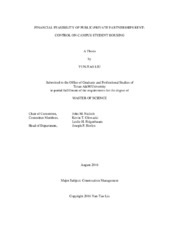| dc.description.abstract | This research considers White Creek Apartments at Texas A&M University and Prince House at National Taiwan University as the research objects, and principally the financial feasibility of these two dormitory projects is discussed and the economic model is used to discuss the utility of this form of providing housing. The two examples were chosen because they represent simple examples from two major economies of interest, the US and the Taiwan economies. The charging rates at Prince House are similar to those of White Creek Apartments, which makes the economic comparisons somewhat simpler.
In this thesis, the Public-Private Partnership (PPP) project financing method is briefly introduced as a construction model for other such facilities. Two projects that used PPP are analyzed for this simple case study. The research reviews these projects in different financial climates, and calculates the effect of the financial aspects of the projects and the local economy on the projects’ viability. Finally, the hypothesis that projects financed by Public-Private Partnerships are financially robust against diverse economic circumstances is shown to be true for these two projects.
During the analysis of financial feasibility, White Creek Apartments shows a strong income source due to their choice of floor plans. Nevertheless, Prince House has more steady net present profit because of their use of different funding mechanisms, interest rates, and repayment periods. The conclusive reason for the difference in profit is the different characteristics of equity, loans, and bonds. If the initial interest amount is kept the same, a project financed by bonds will cost more. Also, the market interest rate will make the initial repayment larger if the private company chooses to obtain a loan.
White Creek Apartments and Prince House both have strong financial feasibility, as their design fits the demand. The difference in financing methods is based on their different financial objectives, such as repayment flexibility or initial repayment amount.
Either model works, although in the long run, one wonders at the ultimate utility of state provided facilities of this form. | en |


